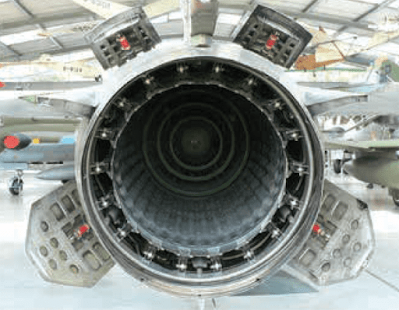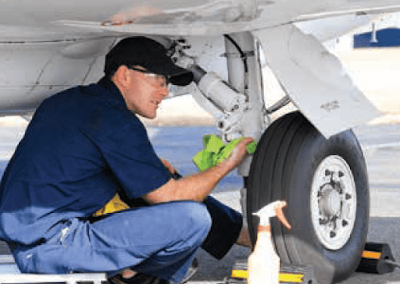Discussed briefly in this section are most of the corrosion problem areas common to all aircraft. These areas should be cleaned, inspected, and treated more frequently than less corrosion prone areas. This information is not necessarily complete and may be amplified and expanded to cover the special characteristics of the particular aircraft model involved by referring to the applicable maintenance manual.
RELATED POSTS
Exhaust Trail Areas
Both jet and reciprocating engine exhaust deposits are very corrosive and give particular trouble where gaps, seams, hinges, and fairings are located downstream from the exhaust pipes or nozzles. [Figure 1]
Deposits may be trapped and not reached by normal cleaning methods. Pay special attention to areas around rivet heads and in skin lap joints and other crevices. Remove and inspect fairings and access plates in the exhaust areas. Do not overlook exhaust deposit buildup in remote areas, such as the empennage surfaces. Buildup in these areas is slower and may not be noticed until corrosive damage has begun.
Battery Compartments and Battery Vent Openings
Despite improvements in protective paint finishes and in methods of sealing and venting, battery compartments continue to be corrosion prone areas. Fumes from overheated electrolyte are difficult to contain and spread to adjacent cavities, causing a rapid corrosive attack on all unprotected metal surfaces. Battery vent openings on the aircraft skin should be included in the battery compartment inspection and maintenance procedure. If aircraft batteries with electrolytes, sulfuric acid, or potassium hydroxide are in use, their leakage will cause corrosion. Regular cleaning and neutralization of acid deposits minimizes corrosion from this cause. Consult the applicable maintenance manuals for the particular aircraft to determine the type of battery installed and the recommended maintenance.
Bilge Areas
These are natural collection points for waste hydraulic fluids, water, dirt, and odds and ends of debris. Residual oil quite often masks small quantities of water that settle to the bottom and set up a hidden chemical cell.
Instead of using chemical treatments for the bilge water, current float manufacturers recommend the diligent maintenance of the internal coatings applied to the float’s interior during manufacture. In addition to chemical conversion coatings applied to the surface of the sheet metal and other structural components and to sealants installed in lap joints during construction, the interior compartments are painted to protect the bilge areas. When seaplane structures are repaired or restored, this level of corrosion protection must be maintained.
Lavatories, Buffets, and Galleys
These areas, particularly deck areas behind lavatories, sinks, and ranges, where spilled food and waste products may collect if not kept clean, are potential trouble spots. Even if some contaminants are not corrosive in themselves, they attract and retain moisture and, in turn, cause corrosive attack. Pay attention to bilge areas located under galleys and lavatories. Clean these areas frequently and maintain the protective sealant and paint finishes.
Wheel Well and Landing Gear
More than any other area on the aircraft, this area probably receives more punishment due to mud, water, salt, gravel, and other flying debris. [Figure 2] Because of the many complicated shapes, assemblies, and fittings, complete area paint film coverage is difficult to attain and maintain. A partially applied preservative tends to mask corrosion rather than prevent it. Due to heat generated by braking action, preservatives cannot be used on some main landing gear wheels.
During inspection of this area, pay particular attention to the following trouble spots:
- Magnesium wheels, especially around bolt heads, lugs, and wheel web areas, for the presence of entrapped water or its effects
- Exposed rigid tubing, especially at B-nuts and ferrules, under clamps and tubing identification tapes
- Exposed position indicator switches and other electrical equipment
- Crevices between stiffeners, ribs, and lower skin surfaces that are typical water and debris traps
- Axle interiors
- Exposed surfaces of struts, oleos, arms, links, and attaching hardware (bolts, pins, etc.)
Water Entrapment Areas
Design specifications require that aircraft have drains installed in all areas where water may collect. Daily inspection of low point drains is a standard requirement. If this inspection is neglected, the drains may become ineffective because of accumulated debris, grease, or sealants.
Engine Frontal Areas and Cooling Air Vents
These areas are being constantly abraded with airborne dirt and dust, bits of gravel from runways, and rain erosion, leading to removal of the protective finish. Furthermore, cores of radiator coolers, reciprocating engine cylinder fins, etc., may not be painted due to the requirement for heat dissipation. Engine accessory mounting bases usually have small area of unpainted magnesium or aluminum on the machined-mounted surfaces. Inspection of these areas must include all sections in the cooling air path, with special attention to places where salt deposits may be built up during marine operations. It is imperative that incipient corrosion be inhibited and that paint touchup and hard film preservative coatings are maintained on seaplane and amphibian engine surfaces at all times.
Wing Flap and Spoiler Recesses
Dirt and water may collect in flap and spoiler recesses unnoticed, because they are normally retracted. For this reason, these recesses are potential corrosion problem areas. Inspect these areas with the spoilers and flaps in the fully deployed position.
External Skin Areas
External aircraft surfaces are readily visible and accessible for inspection and maintenance. Even here, certain types of configurations or combinations of materials become troublesome under certain operating conditions and require special attention.
Relatively little corrosion trouble is experienced with magnesium skins if the original surface finish and insulation are adequately maintained. Trimming, drilling, and riveting destroy some of the original surface treatment and can never be completely restored by touchup procedures. Any inspection for corrosion must include all magnesium skin surfaces with special attention to edges, areas around fasteners, and cracked, chipped, or missing paint.
Piano-type hinges are prime spots for corrosion due to the dissimilar metal contact between the steel pin and aluminum hinge. They are also natural traps for dirt, salt, and moisture. Inspection of hinges must include lubrication and actuation through several cycles to ensure complete lubricant penetration. Use water-displacing lubricants when servicing piano hinges. [Figures 3 and 4]
Corrosion of metal skins joined by spot welding is the result of the entrance and entrapment of corrosive agents between the layers of metal. This type of corrosion is evidenced by corrosion products appearing at the crevices where the corrosive agents enter. More advanced corrosive attack causes skin buckling and eventual spot weld fracture. Skin buckling in its early stages may be detected by sighting along spot welded seams or by using a straightedge. The only technique for preventing this condition is to keep potential moisture entry points, including seams and holes created by broken spot welds, filled with a sealant or a suitable preservative compound.
Electronic and Electrical Compartments
Electronic and electrical compartments cooled by ram air or compressor bleed air are subjected to the same conditions common to engine and accessory cooling vents and engine frontal areas. While the degree of exposure is less, because a lower volume of air passing through and special design features incorporated to prevent water formation in enclosed spaces, this is still a trouble area that requires special attention.
Circuit breakers, contact points, and switches are extremely sensitive to moisture and corrosive attack, thus inspection is required for these conditions as thoroughly as design permits. If design features hinder examination of these items while in the installed condition, inspection is accomplished after component removal for other reasons.
Miscellaneous Trouble Areas
Helicopter rotor heads and gearboxes, in addition to being constantly exposed to the elements, contain bare steel surfaces, many external working parts, and dissimilar metal contacts. Inspect these areas frequently for evidence of corrosion. The proper maintenance, lubrication, and the use of preservative coatings can prevent corrosion in these areas.
All control cables, whether plain carbon steel or corrosion-resistant steel, are to be inspected to determine their condition at each inspection period. In this process, inspect cables for corrosion by random cleaning of short sections with solvent soaked cloths. If external corrosion is evident, relieve tension and check the cable for internal corrosion. Replace cables that have internal corrosion. Remove light external corrosion with a nonwoven abrasive pad lightly soaked in oil or, alternatively, a steel wire brush. When corrosion products have been removed, recoat the cable with preservative.
RELATED POSTS




